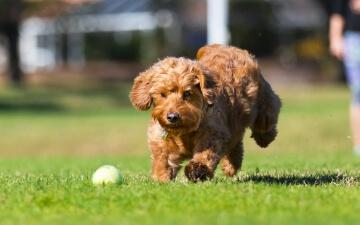

What Is CIRDC?
CIRDC, aka “kennel cough,” is a highly contagious respiratory disease caused by infection with one or more viruses and/or bacteria that can affect your dog's respiratory tract. All breeds and ages are susceptible. Dogs are particularly at risk when exposed to settings where multiple dogs typically gather or live. These communal places include shelters, daycare facilities, or kennels, hence the name kennel cough. There are several different types of bacteria and viruses that can contribute to kennel cough, and dogs can even be infected by more than one.
Bordetella Bronchiseptica
Bordetella bronchiseptica is a bacterium that spreads through direct and indirect contact such as licking, nuzzling, or sharing of contaminated objects. It can also be spread through the air as a result of coughing or sneezing. Transmission is possible between cats and dogs. CIRDC cough is sometimes referred to as Bordetella.
Canine Parainfluenza Virus (CPIV)
Canine parainfluenza virus (CPIV) is a highly contagious respiratory virus typically transmitted through the air and spreads rapidly through spaces where large numbers of dogs are kept together.
Canine Adenovirus Type 2 (CAV-2)
Canine adenovirus Type 2 (CAV-2) is spread directly from dog to dog through infected respiratory secretions, and contact with contaminated feces or urine.
Dogs can become infected with kennel cough when they inhale bacteria or virus particles. Typically, a dog’s respiratory tract is lined with a coating of mucus that helps protect them. However, there are factors that can weaken this protection and leave dogs vulnerable to infection.
These factors include:
- • Not currently vaccinated
- • Crowded conditions such as kennels or shelters
- • Cold temperatures
- • Dust or cigarette smoke
- • Travel-induced stress

What Are Some Signs of Kennel Cough?
The most common and prevalent symptom of kennel cough is a persistent, forceful cough that can sound like a goose honk. This cough has also been described as a gagging or retching, sometimes accompanied by a froth that is similar to vomit. The cough can worsen after exercise.
However, some dogs may show other signs such as sneezing, a runny nose, or eye discharge. In more severe infections, your dog may suffer from lethargy, decreased appetite, fever, and rapid or labored breathing. The latter can indicate a more serious infection, and immediate veterinary attention is needed.

Are There Kennel Cough Treatments Available?
The majority of kennel cough cases will resolve without medications. However, your veterinarian may prescribe medications depending on the severity.
If you suspect your dog has kennel cough, talk to your vet immediately. You can also try to minimize coughing by keeping your dog in a well-humidified area and using a harness as opposed to a collar. Remember, kennel cough is incredibly infectious. While your dog is recovering, try to keep him away from other dogs.

Is There a Way to Help Prevent Kennel Cough?
Because kennel cough can be airborne, normal cleaning and disinfecting of kennel surfaces won’t completely eliminate the chances your dog can be infected by it. The best way to help protect your dog is to keep him up to date on his vaccinations.
Vaccination against CIRDC is considered a non-core vaccine, which means your veterinarian will recommend the vaccine based on your pet’s lifestyle. There are many types of vaccines for CIRDC, including oral and intranasal. Speak to your veterinarian about which options they offer and recommend. Intranasal and oral vaccines have a fast onset (one study showed onset of an oral vaccine within 1 week of administration), and they often do not require a booster if given orally or intranasally.1
Remember, not every cough is kennel cough. There are numerous causes of cough in dogs, some more serious than others. Don’t take any chances; coughing of any kind is best checked out by your veterinarian.
Watch for signs. If your dog displays severe signs such as a decreased appetite, discharge from the eyes or nose, difficulty breathing, or is noticeably less active than normal, a more serious problem may be present.
Reference
- 1. Scott-Garrard MM, Chiang YW, David F. Comparative onset of immunity of oral and intranasal vaccines against challenge with Bordetella bronchiseptica. Vet Rec Open. 2018 Aug 13;5(1):e000285.
Related Articles


If your dog has a dry cough, it could be a sign of several different conditions, some mild, others very serious...


Regular vet visits are essential to keep your dog healthy. But just how often do you need to go?...


Congratulations on your new puppy! Understandably, adding a new dog to your home is accompanied with some questions...







